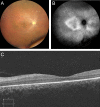A diagnostic conundrum in Bardet-Biedl syndrome: when genetic diagnosis precedes clinical diagnosis
- PMID: 37997784
- PMCID: PMC10762549
- DOI: 10.1530/EDM-23-0055
A diagnostic conundrum in Bardet-Biedl syndrome: when genetic diagnosis precedes clinical diagnosis
Abstract
Summary: Bardet-Biedl syndrome (BBS) is a rare, autosomal recessive, multisystem non-motile ciliopathy of progressive onset. It is primarily characterised by rod-cone dystrophy, early-onset obesity and related complications, postaxial polydactyly, renal and genitourinary abnormalities, learning disabilities, and hypogonadism. The diagnosis is based on Beales' modified diagnostic criteria. We present a case of two monozygotic female twins, 17 years of age at presentation, referred for obesity since childhood. The initial hormonal work-up was negative and no dysmorphic features were noted. They were diagnosed with exogenous obesity. However, after ophthalmologic problems became apparent, rod-cone dystrophy was observed and genetic testing was performed. A mutation in the BBS2 gene led to the diagnosis of BBS, although the full diagnostic criteria were not met. This case not only highlights the need to raise awareness for BBS but also exposes two limitations of the current diagnostic standard. The first limitation is the low sensitivity of the clinical diagnostic model, due to the progressive onset and the high variability of the syndrome. The second limitation is the unclear role of genetic testing. As genetic testing becomes more widely available, genetic diagnosis preceding clinical diagnosis will become more common, leading to a diagnostic conundrum. We propose an update of the diagnostic model. A less strict application in the presence of confirmed genetic mutations should be applied, as this could facilitate earlier diagnosis and intervention. This is important because therapeutic agents are being developed that could have a significant impact on quality of life and prognosis.
Learning points: Due to the low prevalence, the significant inter-and intrafamilial variation, and the slowly evolving phenotype, monogenic forms of obesity such as Bardet-Biedl syndrome are difficult to diagnose. Despite advances in the understanding of the presentation, pathophysiology and access to accurate genetic characterisation, a substantial number of diagnoses are still made by ophthalmology, as recognition of BBS in other departments of medicine, remains limited. Clinical diagnosis of BBS is based on Beales' modified diagnostic criteria which require the presence of four primary features or three primary features plus two secondary features. This model has its limitations. Due to the progressive onset of clinical symptoms, patients generally do not meet the diagnostic criteria early in life, leading to a delay in diagnosis. In addition, the role of genetic testing remains controversial. However, as it becomes more widely available, genetic diagnosis may precede a full clinical diagnosis. BBS has an impact on the quality of life and prognosis of both the patient and the family. Obesity management strategies are an important part of the multidisciplinary approach, as there is no cure available. Setmelanotide has shown promising results in a phase 3 trial, but its effect in clinical practice remains unproven.
Conflict of interest statement
The authors declare that they have no competing interests that might be perceived as prejudicing the impartiality of the case study reported.
Figures

References
-
- Radha V & Mohan V. Obesity–Are we continuing to play the genetic “blame game”. Advances in Genomics and Genetics 201661–23. (10.2147/AGG.S52018) - DOI
-
- Moore SJ Green JS Fan Y Bhogal AK Dicks E Fernandez BA Stefanelli M Murphy C Cramer BC & Dean JC. Clinical and genetic epidemiology of Bardet–Biedl syndrome in newfoundland: a 22‐year prospective, population‐based, cohort study. American Journal of Medical Genetics. Part A 2005132352–360. (10.1002/ajmg.a.30406) - DOI - PMC - PubMed
-
- Mujahid S, Hunt KF, Cheah YS, Forsythe E, Hazlehurst JM, Sparks K, Mohammed S, Tomlinson JW, Amiel SA, Carroll PV, et al.The endocrine and metabolic characteristics of a large Bardet-Biedl syndrome clinic population. Journal of Clinical Endocrinology and Metabolism 20181031834–1841. (10.1210/jc.2017-01459) - DOI - PubMed
LinkOut - more resources
Full Text Sources
Research Materials
Miscellaneous

